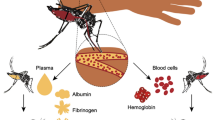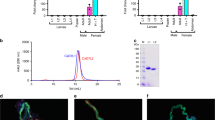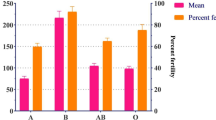Abstract
Gorging is stimulated in some insects by plasma components alone. In other insects engorgement is maximal only when blood cell components are present in addition to the plasma. Plasma components recognized by insects are NaCl, NaHC03 (some anopheline mosquitoes) and albumin (Anopheles dims and Pediculus humanus). Those requiring blood cells recognize this fraction by its adenine nucleotides which, for optimal engorgement, have to be offered in the presence of isotonic NaCl solution buffered by NaHC03 (i.e. Rhodnius, culicine mosquitoes, Simulium, tsetse and Tabanus). The presence of albumin in the feeding medium may lower the level of nucleotides required to induce gorging (i.e. Aedes). For most haematophagous insects requiring the cellular fraction, ATP is the most effective phagostimulant. It may however be replaced quite effectively by non-hydrolyzable analogues, indicating that ATP is not essential as a source of energy for the gustatory receptors involved in blood meal recognition.
Résumé
L’engorgement est stimulé chez certains insectes seulement par les composants du plasma. Chez d’autres insectes l’engorgement maximal n’est obtenu qu’en présence des composants des cellules du sang, en plus de ceux du plasma. Les composants du plasma reconnus par les insectes sont NaCl, NaHCO3 (certains anophèles) et l’albumine (Anopheles dirus et Pediculus humanus). Les insectes exigeant la présence des cellules du sang, reconnaissent cette fraction à ses nucléotides d’adenine. Pour que l’engorgement soit maximal ceux-ci doivent être présentés dans une solution tampon physiologique (NaCl/NaHCO3 ) (p.e. Rhodnius, culicidés, Simulium, mouches tsé-tsé et Tabanus). La présence d’albumine dans le milieu nutritif peut abaisser le niveau des nucleotides nécessaire pour provoquer l’engorgement (p.e. Aedes). Pour la plupart des insectes hematophages qui exigent la fraction cellulaire, l’ATP est le phagostimulant le plus efficace. On peut cependant le remplacer par des analogues non hydrolysables tout aussi efficaces. Ceci indique que l’ATP n’est pas une source d’énergie essentielle pour les récepteurs gustatifs concernés dans la reconnaissance du sang.
Similar content being viewed by others
References
Cross H. F. and Wharton G. W. (1966) Feeding tests with several species of mites on different kinds of blood and blood components. Ann. Ent. Soc. Am. 59, 182–185.
Friend W. G. (1965) The gorging response in Rhodnius prolixus. Can. J. Zool. 43, 125–132.
Friend W. G. (1978) Physical factors affecting the feeding responses of Culiseta inornata to ATP, sucrose and blood. Ann. Ent. Soc. Am. 74, 151–154.
Friend W. G. and Smith J. J. B. (1971) Feeding in Rhodnius prolixus: mouthparts activity and salivation and their correlation with changes of electrical resistance. J. Insect Physiol. 17, 233–243.
Friend W. G. and Smith J. J. B. (1982) ATP analogues and other phosphate compounds as gorging stimulants of Rhodnius prolixus. J. Insect Physiol. 28, 371–376.
Friend W. G. and Stoffolano J. G. (1983) Feeding response of the horsefly, Tabanus nigrovittatus, to phagostimulants. Phys. Ent. 8, 377–383.
Galun R. (1966) Feeding stimulants of the rat flea Xeno- psylla cheopis. Life Sci. 5, 1335–1342.
Galun R. (1975) The role of host blood in the feeding behavior of ectoparasites. In: Dynamic Aspects of Host-Parasite Relationships (Edited by Zuckerman A.), pp. 132–162, Keter Publishing House, Jerusalem.
Galun R. (1976) Regulation of feeding in the tick Ornithodoros tholozani. In: Tick-borne Diseases and their Vectors (Edited by Wilele J. K. H.), pp. 64–67. University of Edinburgh.
Galun R., Avidor Y. and Bar-Zeev M. (1963) Feeding response in Aedes aegypti: stimulation by ATP. Science 142, 1674–1675.
Galun R. and Kindler S. H. (1965) Glutathione as an inducer of feeding in the tick Ornithodoros tholozani. Science 147, 166–167.
Galun R. and Kindler S. H. (1968) Chemical basis of feeding in the tick Ornithodoros tholozani. J. Insect Physiol. 14, 1409–1421.
Galun R., Koontz L. C and Gwadz R. W. (1985) Engorgement response of anopheline mosquitoes to blood fractions and artificial solutions. Physiol. Ent. 10, 145–149.
Galun R., Koontz L. C, Gwadz R. W. and Ribeirro J. M. C (1985) Effect of ATP analogues on the gorging response of the mosquito Aedes aegypti. Physiol. Ent. 10, 275–282.
Galun R., Oren N. and Zecharia M. (1984) Effect of plasma components on the feeding response of the mosquito Aedes aegypti to adenine nucleotides. Physiol. Ent. 9, 403–408.
Galun R., Sternberg S. and Mango C. (1978) Effects of host spectra on feeding behaviour and reproduction of soft ticks. Bull. ent. Res. 68, 153–157.
Gatehouse A. G. (1970) The probing response of Stomoxys calcitrans, certain physical and olfactory stimuli. J. Insect Physiol. 16, 61–74.
Hosoi T. (1959) Identification of blood components which induce gorging in the mosquito. J. Insect Physiol. 3, 191–218.
Kemp D. H., Stone B. F. and Binington K. C (1982) Tick attachment and feeding: role of the mouthparts, feeding apparatus, salivary gland secretions and host response. In: Physiology of Ticks (Edited by Obenchain, F. D. and Galun R.), pp. 114–168, Pergamon Press.
Kirkwood A. C. (1971) In vitro feeding of Dermanyssus gallinas.Exp. Parasitol. 29, 1–6.
Margalit J., Galun R. and Rice M. J. (1972) Mouthpart sensilla of the tsetse fly and their function. I. Feeding patterns. Ann. Trop. Med. Hyg. 66, 525–536.
Mumcuoglu Y. and Galun R. (1987) Engorgement response of human body lice Pediculus humanus to blood fractions and their components. Physiol. Ent. 12 (in press).
Owen W. B. (1963) The contact chemoreceptor organs of the mosquito and their function in feeding behavior. J. Insect Physiol. 9, 73–87.
Ready P. D. (1978) Feeding habits of laboratory-bred Lutzomia longipalpis. J. Med. Ent. 14, 545–552.
Smith J. J. B. and Friend W. G. (1982a) Feeding behavior in response to blood fractions and chemical phagostimulants in the blackfly Simulium venustum, Physiol. Ent. 7, 219–226.
Smith J. J. B. and Friend W. G. (1982b) Diphospho-glycerate and phytic acid as feeding stimulants for the blood feeding bug Rhodnius prolixus. Comp. Biochem. Phys. 72A, 133–136.
Author information
Authors and Affiliations
Rights and permissions
About this article
Cite this article
Galun, R. Regulation of Blood Gorging. Int J Trop Insect Sci 8, 623–625 (1987). https://doi.org/10.1017/S1742758400022700
Received:
Published:
Issue Date:
DOI: https://doi.org/10.1017/S1742758400022700




